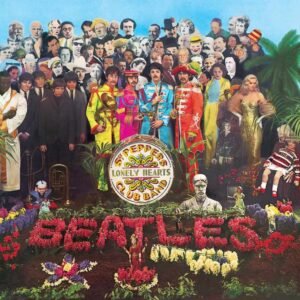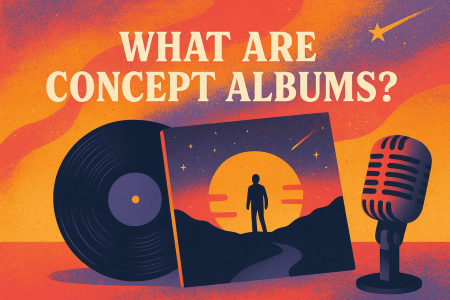What happens when an album becomes more than just a collection of songs? That’s where the idea of a concept album comes in.
A concept album is a record built around a central idea. This can be a story, a theme, or a character that ties each track together. Instead of feeling like a playlist, the album flows with purpose, often unfolding like a novel or a film.
These albums stand out because they ask more from the listener. They invite you into a full experience, not just a series of hits. Whether it’s telling a personal journey or diving deep into a fictional world, concept albums challenge the way we listen to music—and keep us coming back for more.
Core Definition: What Is a Concept Album?
A concept album is a record where every song connects to a single idea. This idea could be a storyline, a theme, or even a character that appears across tracks.
Unlike standard albums, which often feel like a mix of unrelated songs, concept albums are built for cohesion. They are structured to take the listener on a journey from start to finish.
For example, The Wall by Pink Floyd tells the story of a man who isolates himself from the world, brick by brick. Kendrick Lamar’s To Pimp a Butterfly explores race, fame, and identity, tying each track into a broader social message. In both cases, the album is more than just music—it’s a full statement.
A Short History of the Concept Album

The idea of linking songs around a central theme isn’t new. One of the earliest examples is Frank Sinatra’s In the Wee Small Hours from 1955. The album follows a mood of late-night loneliness, setting the stage for what would later become known as the concept album.
By the late 1960s, the format took a big leap. The Beatles’ Sgt. Pepper’s Lonely Hearts Club Band turned the album into an art piece, complete with characters, costumes, and a loose narrative. This kicked off a wave of ambitious storytelling in rock.
The 1970s brought the rise of progressive rock, with bands like Pink Floyd, Genesis, and The Who building albums around detailed stories and elaborate soundscapes. Then came the hip-hop era, where artists used the format to reflect personal and political themes. Albums like Public Enemy’s It Takes a Nation of Millions to Hold Us Back and later, Kendrick Lamar’s Good Kid, M.A.A.D City, pushed the concept album into new territory.
In the 2000s and beyond, pop and R&B artists joined in. Beyoncé’s Lemonade and Janelle Monáe’s The ArchAndroid show how concept albums can blend visual storytelling, genre shifts, and cultural commentary.
With the rise of streaming, the format has had to adapt. Playlists dominate, and many listeners prefer singles over full albums. Even so, concept albums continue to thrive among artists who want to build a deeper connection with their audience. They may not always follow a strict storyline, but the intent to create a full, immersive experience remains strong.
Types of Concept Albums
Not all concept albums follow the same structure. Some tell full stories, while others stay grounded in a single idea or emotion. Here’s a quick breakdown of the main types:
Narrative Albums
These albums tell a story from beginning to end. Each track acts like a chapter, moving the plot forward. A good example is Green Day’s American Idiot, which follows a fictional character named Jesus of Suburbia through rebellion, disillusionment, and self-discovery.
Thematic Albums
Instead of telling a story, these albums center around a unifying theme, mood, or idea. The songs may stand alone, but they all point back to a shared focus. For example, Beyoncé’s Lemonade explores identity, heartbreak, and healing across a range of styles and perspectives.
Hybrid or Abstract Concepts
Some albums blend both approaches or keep things more open-ended. These records might suggest a loose narrative or vibe without spelling it all out. Radiohead’s Kid A is often seen this way—it doesn’t tell a clear story, but its sonic and emotional consistency gives it the feel of a unified whole.
Why Artists Make Them
Concept albums give artists a chance to stretch beyond the usual format. They’re not just making songs—they’re building worlds.
Creative Freedom
A concept album allows more room for experimentation. Artists can explore different sounds, storylines, and structures without being tied to radio-friendly singles.
Artistic Identity
It’s a way to define or redefine who they are. By committing to a concept, an artist can showcase their vision and make a statement that stands out from the crowd.
Cultural or Political Commentary
Some artists use concept albums to dig into bigger issues. Whether it’s race, gender, class, or mental health, the format gives them space to explore complex topics with depth and nuance.
Fan Engagement and Legacy
Concept albums often become milestones in an artist’s career. They encourage fans to listen closely, follow the narrative, and dive into lyrics, visuals, and hidden meanings. These projects stick with people—and they help build lasting legacies.
How to Spot a Concept Album
You don’t always need a press release to tell if an album is a concept album. There are a few signs to look out for:
Story Arcs and Recurring Motifs
If the lyrics follow a storyline or bring back the same characters, phrases, or themes, that’s a strong clue. Some albums even use spoken interludes or sound effects to connect the dots.
Lyrical and Sonic Consistency
Pay attention to the mood and message. If every track circles around the same idea—like heartbreak, identity, or survival—it’s likely a thematic concept. The production might also stick to a certain style or atmosphere to support that idea.
Visual Cohesion
The album art, music videos, and even live performances often match the concept. Artists may build an entire visual world around the album, from costumes to set design, to keep everything on theme.
Do Concept Albums Still Matter?
In a music world dominated by playlists and singles, concept albums might seem like a thing of the past. But they’re far from fading—they’re evolving.
Today’s artists are finding new ways to tell stories and build cohesive projects, even in the age of streaming. Some albums lean into visuals, others use interludes or recurring themes, but the core idea remains the same: create something that holds together from start to finish.
Concept albums still offer something that single tracks can’t—a complete artistic statement. They ask listeners to slow down, pay attention, and take in the full picture.
So next time you press play on a new album, ask yourself: is this just a collection of songs, or is there something more going on?
